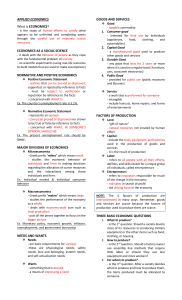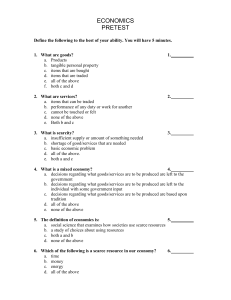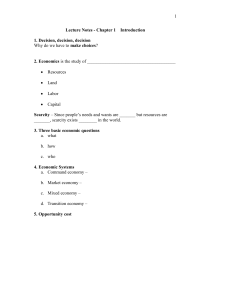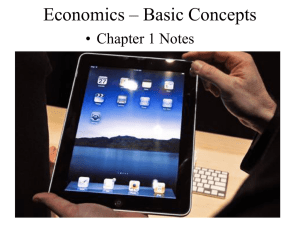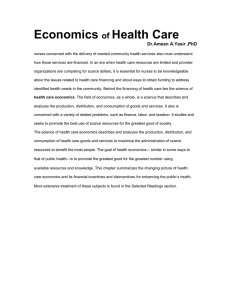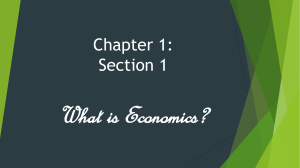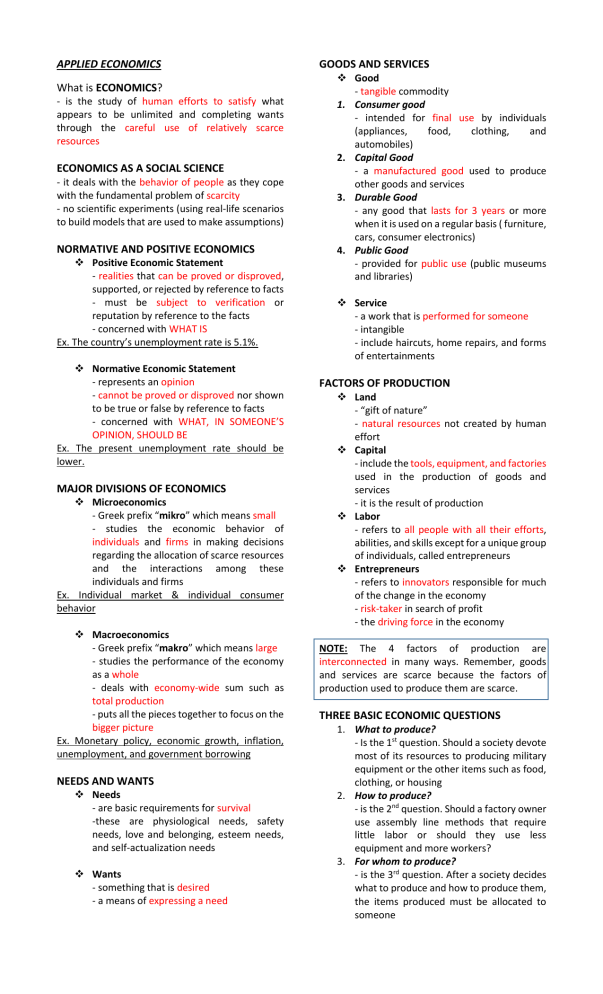
APPLIED ECONOMICS What is ECONOMICS? - is the study of human efforts to satisfy what appears to be unlimited and completing wants through the careful use of relatively scarce resources ECONOMICS AS A SOCIAL SCIENCE - it deals with the behavior of people as they cope with the fundamental problem of scarcity - no scientific experiments (using real-life scenarios to build models that are used to make assumptions) NORMATIVE AND POSITIVE ECONOMICS Positive Economic Statement - realities that can be proved or disproved, supported, or rejected by reference to facts - must be subject to verification or reputation by reference to the facts - concerned with WHAT IS Ex. The country’s unemployment rate is 5.1%. Normative Economic Statement - represents an opinion - cannot be proved or disproved nor shown to be true or false by reference to facts - concerned with WHAT, IN SOMEONE’S OPINION, SHOULD BE Ex. The present unemployment rate should be lower. MAJOR DIVISIONS OF ECONOMICS Microeconomics - Greek prefix “mikro” which means small - studies the economic behavior of individuals and firms in making decisions regarding the allocation of scarce resources and the interactions among these individuals and firms Ex. Individual market & individual consumer behavior Macroeconomics - Greek prefix “makro” which means large - studies the performance of the economy as a whole - deals with economy-wide sum such as total production - puts all the pieces together to focus on the bigger picture Ex. Monetary policy, economic growth, inflation, unemployment, and government borrowing NEEDS AND WANTS Needs - are basic requirements for survival -these are physiological needs, safety needs, love and belonging, esteem needs, and self-actualization needs Wants - something that is desired - a means of expressing a need GOODS AND SERVICES Good - tangible commodity 1. Consumer good - intended for final use by individuals (appliances, food, clothing, and automobiles) 2. Capital Good - a manufactured good used to produce other goods and services 3. Durable Good - any good that lasts for 3 years or more when it is used on a regular basis ( furniture, cars, consumer electronics) 4. Public Good - provided for public use (public museums and libraries) Service - a work that is performed for someone - intangible - include haircuts, home repairs, and forms of entertainments FACTORS OF PRODUCTION Land - “gift of nature” - natural resources not created by human effort Capital - include the tools, equipment, and factories used in the production of goods and services - it is the result of production Labor - refers to all people with all their efforts, abilities, and skills except for a unique group of individuals, called entrepreneurs Entrepreneurs - refers to innovators responsible for much of the change in the economy - risk-taker in search of profit - the driving force in the economy NOTE: The 4 factors of production are interconnected in many ways. Remember, goods and services are scarce because the factors of production used to produce them are scarce. THREE BASIC ECONOMIC QUESTIONS 1. What to produce? - Is the 1st question. Should a society devote most of its resources to producing military equipment or the other items such as food, clothing, or housing 2. How to produce? - is the 2nd question. Should a factory owner use assembly line methods that require little labor or should they use less equipment and more workers? 3. For whom to produce? - is the 3rd question. After a society decides what to produce and how to produce them, the items produced must be allocated to someone

